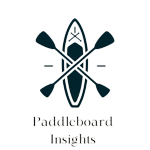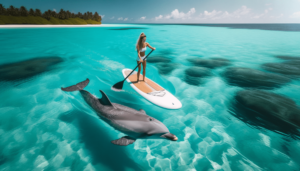As the sun dips below the horizon, casting a golden glow across the endless expanse of the ocean, a sense of freedom washes over the paddleboarder. With each stroke of the paddle, they navigate the vast blue, feeling a connection to nature unlike any other.
For beginners seeking this liberating experience, there are four essential tips to ensure a successful ocean paddleboarding adventure. From choosing the right paddleboard to mastering techniques, this article provides expert advice to unleash the adventurer within.
Choosing the Right Paddleboard
One important step for beginners in ocean paddleboarding is to choose the right paddleboard. When it comes to paddleboard size, it’s crucial to find one that suits your body type and skill level. A general rule of thumb is to choose a longer and wider board for stability, especially if you’re new to paddleboarding. However, if you’re more experienced and looking for speed and maneuverability, a narrower board might be a better choice. It’s also essential to consider the weight capacity of the paddleboard to ensure it can support your weight and any additional gear you may bring along.
Another factor to consider when choosing a paddleboard is the material it’s made of. There are typically three main options: foam, inflatable, and epoxy. Foam paddleboards are lightweight and beginner-friendly, making them a popular choice. Inflatable paddleboards, on the other hand, are convenient for transportation and storage but may not offer the same level of stability as foam or epoxy boards. Epoxy paddleboards are known for their durability and performance, making them suitable for more advanced paddleboarders.
Essential Safety Gear
To ensure personal safety on the water, beginners in ocean paddleboarding should equip themselves with essential gear. Here are some must-have items to consider:
-
PFD (Personal Flotation Device): This is the most important piece of safety gear for any paddleboarder. A PFD will keep you afloat in case you fall off your board, especially if you’re not a strong swimmer. It’s crucial to choose a PFD that’s comfortable and properly fitted to your body.
-
Leash: A leash connects you to your paddleboard, preventing it from drifting away in case of a fall. This is especially important when dealing with strong ocean currents or choppy conditions. Always attach the leash to your ankle or calf, ensuring that you can easily detach it if needed.
-
Whistle: A whistle is a simple yet effective way to signal for help if you find yourself in trouble. It’s a small, lightweight item that can easily be attached to your PFD or leash for quick access.
-
Sun Protection: The ocean can be a harsh environment, so it’s essential to protect your skin and eyes from the sun’s harmful rays. Wear sunscreen, a hat, and sunglasses to shield yourself from the elements.
Mastering Paddleboarding Techniques
To improve their skills in ocean paddleboarding, beginners should focus on mastering the techniques of paddling and balancing on the board. Balancing and body positioning are crucial aspects of paddleboarding, as they determine stability and control on the water. Beginners should start by placing their feet shoulder-width apart, with knees slightly bent and weight evenly distributed. This helps maintain balance and allows for better maneuverability.
Efficient paddle strokes are also essential for mastering paddleboarding techniques. Beginners should hold the paddle with a relaxed grip, placing one hand on the top of the handle and the other hand slightly down the shaft. By engaging their core muscles and rotating their torso, beginners can generate power and paddle more efficiently. It’s important to keep the paddle close to the board and use the entire blade surface when stroking through the water.
Exploring the Best Ocean Paddleboarding Spots
Beginners can discover a multitude of breathtaking ocean paddleboarding spots to explore. These spots offer a sense of freedom and adventure, allowing paddleboarders to immerse themselves in the beauty of nature while enjoying the physical benefits of the activity.
Here are some of the best ocean paddleboarding spots to consider:
-
La Jolla Cove, California: With its crystal-clear waters and abundant marine life, La Jolla Cove provides a picturesque setting for paddleboarding. Beginners can paddle alongside playful sea lions and explore the vibrant underwater ecosystem.
-
Bora Bora, French Polynesia: Known for its turquoise lagoons and stunning coral reefs, Bora Bora offers a unique paddleboarding experience. As you glide over the clear waters, you’ll be surrounded by breathtaking scenery and have the opportunity to spot tropical fish and other marine creatures.
-
Bondi Beach, Australia: This iconic beach in Sydney isn’t only famous for its surf, but also for its paddleboarding opportunities. Beginners can enjoy the gentle waves and panoramic views of the coastline while improving their balance and core strength.
-
Hanalei Bay, Hawaii: Nestled on the island of Kauai, Hanalei Bay is a paradise for paddleboarders. With its calm waters and lush surroundings, it provides an idyllic setting for beginners to practice their skills and enjoy the tranquility of the ocean.
When exploring these ocean paddleboarding spots, it’s essential to follow ocean paddleboarding etiquette, such as respecting marine life and other water users. Additionally, the benefits of ocean paddleboarding for physical fitness can’t be overlooked, as it provides a full-body workout that improves balance, strength, and cardiovascular endurance.
Frequently Asked Questions
What Are the Different Types of Paddleboards Available for Ocean Paddleboarding?
Different paddleboard materials include fiberglass, carbon fiber, and inflatable paddleboards. Fiberglass boards are lightweight and durable, while carbon fiber boards are even lighter and more rigid. Inflatable paddleboards offer portability and easy storage, but may lack the same performance as solid boards.
How Do I Properly Attach the Leash to My Paddleboard?
To properly attach the leash to a paddleboard, beginners must prioritize safety. There are different methods available, such as ankle or calf attachment. Following the correct method ensures that the paddleboard stays connected, providing freedom and peace of mind.
Are There Any Specific Techniques or Tips for Paddling Against Strong Ocean Currents?
Are there any specific techniques or tips for paddling against strong ocean currents? Understanding how to read ocean currents and paddleboarding in rough conditions can help beginners navigate safely and confidently in challenging waters.
What Should I Do if I Fall off My Paddleboard in Deep Water?
If a beginner falls off their paddleboard in deep water, it’s important to prioritize water safety. They should remain calm and try to climb back on the board or signal for help. Knowing basic paddleboard rescue techniques can be invaluable in such situations.
Are There Any Regulations or Restrictions for Paddleboarding in Certain Ocean Areas?
In certain ocean areas, there may be regulations or restrictions for paddleboarding. It is important for beginners to be aware of any safety measures and to check weather conditions before heading out.


